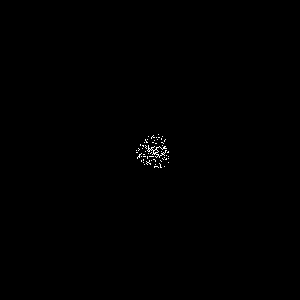“布莱恩大脑”的版本间的差异
(→规则) |
|||
| 第17行: | 第17行: | ||
* 死亡(dying):所有存活的细胞,在下一个时间步中都会死亡。 | * 死亡(dying):所有存活的细胞,在下一个时间步中都会死亡。 | ||
* 等待(off):所有死亡的细胞,在下一个时间步中都会变成等待。 | * 等待(off):所有死亡的细胞,在下一个时间步中都会变成等待。 | ||
| + | |||
| + | ==类比== | ||
| + | |||
| + | 可以清楚地看到该规则同大脑神经元规则之间的类比: | ||
| + | * 存活-去极化:神经元受到刺激,发放了一个脉冲。 | ||
| + | * 死亡-超极化:神经元进入不应期,在该阶段即使接受刺激也不发放脉冲。 | ||
| + | * 等待-恢复静息电位:不应期后恢复静息电位,又可以重新对刺激进行反应 | ||
| + | |||
| + | 然而,同布莱恩大脑不同: | ||
| + | * 大脑中的神经之间传递的信息是非线性的,是否发放脉冲同 突触间的连接强度、信息编码规则等有关系,而不只是两个相邻细胞输入刺激就发放脉冲。 | ||
| + | * 大脑中的一个神经元,可以从数千个神经元接收信息,再向数千个神经元发放信息;人脑中神经元突触数量约在1014一1015(百万亿~千万亿)之间。 | ||
| + | |||
| + | 因此真实大脑处理信息的过程要复杂得多得多。 | ||
==表现== | ==表现== | ||
2020年5月19日 (二) 17:13的版本
介绍
布莱恩的大脑(Brain's brain)是由加拿大计算机科学家布莱恩·西尔弗曼(Brian Silverman)设计的元胞自动机。
其特点在于,规则模拟了大脑神经元之间的信息传递规则。
规则
Brain’s Brain在一个无限的二维细胞网格上运行,每个细胞处于3种状态,且状态受到周围的8个邻域细胞的影响,这八个细胞是水平、垂直或对角线相邻的细胞。 同康威生命游戏的主要区别在于,生命游戏的细胞只有两种状态,而布莱恩大脑中有三种状态,且状态更新的规则不同。
每个时间步中发生的变化如下:
- 存活(on):在等待状态的细胞,其8个邻域细胞中的两个细胞处于存活状态时,该细胞存活。
- 死亡(dying):所有存活的细胞,在下一个时间步中都会死亡。
- 等待(off):所有死亡的细胞,在下一个时间步中都会变成等待。
类比
可以清楚地看到该规则同大脑神经元规则之间的类比:
- 存活-去极化:神经元受到刺激,发放了一个脉冲。
- 死亡-超极化:神经元进入不应期,在该阶段即使接受刺激也不发放脉冲。
- 等待-恢复静息电位:不应期后恢复静息电位,又可以重新对刺激进行反应
然而,同布莱恩大脑不同:
- 大脑中的神经之间传递的信息是非线性的,是否发放脉冲同 突触间的连接强度、信息编码规则等有关系,而不只是两个相邻细胞输入刺激就发放脉冲。
- 大脑中的一个神经元,可以从数千个神经元接收信息,再向数千个神经元发放信息;人脑中神经元突触数量约在1014一1015(百万亿~千万亿)之间。
因此真实大脑处理信息的过程要复杂得多得多。
表现
Because of the cellular automaton's name, some websites compare the automaton to a brain and each of its cells to a neuron, which can be in three different states: ready (off), firing (on), and refractory (dying).[1]引用错误:没有找到与</ref>对应的<ref>标签
|date=2001-09-15|work=Mirek's Cellebration documentation|accessdate=2009-05-17}}</ref>
| date 2001-09-15 | work Mirek’s Cellebration documentation | accessdate 2009-05-17} / ref

oscillator in Brian's Brain.]]
布莱恩大脑中的振荡器]]
The "dying state" cells tend to lead to directional movement, so almost every pattern in Brian's Brain is a spaceship. Many spaceships are rakes, which emit other spaceships. Another result is that many Brian's Brain patterns will explode messily and chaotically, and often will result in or contain great diagonal waves of on and dying cells. For example, a 2×2 block of on cells will result in an ever-expanding diamond consisting of four diagonal waves that move across the plane at the pattern's speed of light.
The "dying state" cells tend to lead to directional movement, so almost every pattern in Brian's Brain is a spaceship. Many spaceships are rakes, which emit other spaceships. Another result is that many Brian's Brain patterns will explode messily and chaotically, and often will result in or contain great diagonal waves of on and dying cells. For example, a 2×2 block of on cells will result in an ever-expanding diamond consisting of four diagonal waves that move across the plane at the pattern's speed of light.
“死亡状态”细胞倾向于导致定向运动,所以几乎布莱恩大脑中的每个模式都是一艘宇宙飞船。许多宇宙飞船是耙子,它们发射出其他宇宙飞船。另一个结果是,许多布莱恩的大脑模式将爆炸的混乱和混乱,往往会导致或包含大量对角线波上和死亡的细胞。例如,一个22块的单元将产生一个不断膨胀的钻石,其中包括四个对角线波,它们以光速穿过平面。
Nevertheless, oscillators have been constructed in Brian's Brain. An example has just four on cells and four dying cells, and oscillates with period 3.[2]
Nevertheless, oscillators have been constructed in Brian's Brain. An example has just four on cells and four dying cells, and oscillates with period 3.
然而,在布赖恩的大脑中已经构建了振荡器。一个例子只有四个细胞和四个死亡细胞,周期3振荡。
References
- Resnick, Mitchel 第一个米切尔; Silverman, Brian
2 Silverman,Brian (1996-02-04
日期1996-02-04). "Exploring Emergence: The Brain Rules 探索涌现: 大脑规则". MIT Media Laboratory, Lifelong Kindergarten Group
麻省理工学院媒体实验室,终身幼儿园小组. Archived from [http://llk.media.mit.edu/projects/emergence/mutants.html
Http://llk.media.mit.edu/projects/emergence/mutants.html the original] on 2008-12-23
2008年12月23日. Retrieved 2008-12-15
2008-12-15. {{cite web}}: Check |url= value (help); Check date values in: |accessdate=, |date=, and |archivedate= (help); Invalid |url-status=dead
状态死机 (help); Text "archiveurl https://web.archive.org/web/20081223050254/http://llk.media.mit.edu/projects/emergence/mutants.html" ignored (help); Text "authorlink Mitchel Resnick" ignored (help); Text "last Resnick" ignored (help); line feed character in |accessdate= at position 11 (help); line feed character in |archivedate= at position 11 (help); line feed character in |author2= at position 17 (help); line feed character in |date= at position 11 (help); line feed character in |first= at position 8 (help); line feed character in |publisher= at position 50 (help); line feed character in |title= at position 37 (help); line feed character in |url-status= at position 5 (help); line feed character in |url= at position 57 (help)
}}
}}
- ↑ Evans, M. Steven (2002-01-28). "Cellular Automata - Brian's Brain". Retrieved 2009-05-17.
- ↑ "Archived copy". Archived from the original on 2011-07-23. Retrieved 2009-05-17.
{{cite web}}: CS1 maint: archived copy as title (link)
Category:Cellular automaton rules
分类: 细胞自动机规则
This page was moved from wikipedia:en:Brian's Brain. Its edit history can be viewed at 布莱恩大脑/edithistory
